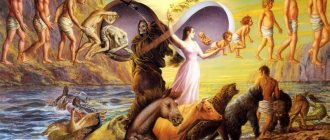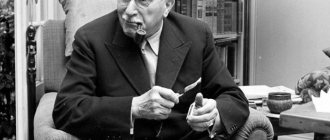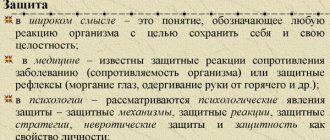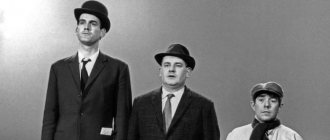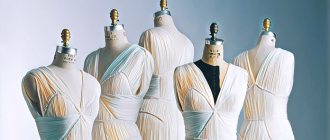According to Freud's theory, the process of personality formation begins at birth and goes through four stages. Each of these stages is associated with a specific area of the body - one or another erogenous zone (mouth, nose, ear, eye, anus, urethra, skin, navel).
On the basis of this idea, academicians V. Ganzen and V. Tolkachev developed vector psychology. This is the doctrine of eight vectors in a person’s character, called “applied system-vector psychoanalysis,” the essence of which boils down to the fact that a person cannot exist alone.
In system-vector psychology, a vector is a set of human qualities that form its system of values, morality, character, and behavioral characteristics. All vectors are innate and do not change throughout life. In this regard, each of these vectors sets a special scenario for a person’s life, and by studying them, you can understand what kind of person this person is and how to behave with him.
There are 8 vectors, that is, 8 types of human “direction”. The vector talks about what exactly a person likes, what kind of self-realization he is instinctively drawn to, what gives him pleasure. To realize his vector in society, a person plays a certain role in it. The name of the vector is identical to the human sensitive zone. So, let's begin:
Muscle vector.
General characteristics a) the color of greatest comfort is black
b) geometry of the greatest comfort - rectangle, brick;
c) place in a quartel - the inner part of the quartel SPACE, introvert - even double introvert
d) type of thinking - practical, involuntary-autistic, visual-effective.
Key task: monotonous physical work for progressive movement towards the goal. Species role: ordinary hunter or gatherer. Possible disadvantages: lack of motivation to improve work.
External signs
- Large build. “Man-mountain.”
- Stable (they say about someone like this: “Stands firmly on the ground”).
- Strong. Body with pronounced muscle relief.
- Wide, thick neck.
A person loves to work his muscles: a sport that allows you to build muscle mass; physical labor, namely carrying heavy loads, working in the field, with heavy equipment - is necessary for them. A person with a muscle vector in the absence of other vectors is a modest person with a minimum of needs and aspirations. Eating, a roof over his head, working, sleeping - the rest: science, art, entrepreneurship - are not for him. In combination with other lower vectors, it strengthens them, as if integrating into their desires and properties.
He doesn’t know how to make decisions, but he is a good performer - he is a follower. Muscular people are almost incapable of acting independently; they will do as they are told. They are unable to clearly express their own opinions; they simply follow the crowd. In their speech, instead of “I,” “we” appears. What a muscular man becomes depends on who is next to him.
Muscle plant perfectly adapts to a stable, unchanging rural landscape. Lives by the principle: as taught. This principle works in muscles in absolutely everything! Psychology of masses, crowds.
Physical labor is what it is necessary to teach a muscular child to do from an early age. He must help his parents; it is very important for him to learn to enjoy work. You need to understand that it is through muscle effort that the thinking of a muscular person is activated. He receives joy when he is engaged in physical labor, which in itself directs him in a peaceful direction. However, sports are strictly prohibited for such children, because they do not like to compete and win, they do not have such properties and data. Sport will only take them from the state of “peace” to the state of “war”.
Death is good for a muscleman; everything connected with life is suspicious for a muscleman, so a muscleman is suspicious of sex. A muscular woman creates a foundation, a foundation, giving birth to new offspring. She is the one who gives birth for real: she mowed the grass, went, gave birth under a haystack, and went on to mow. She gives birth to 10 children each so that there is a greater chance of survival. A muscular man has a contradiction - between life and death, which, however, is easily resolved through monotonous tradition and ritual: everything should be as it is with people, in a human way. When everything is not humane, then there is suspicion, because the program breaks down... not human, this is sex before marriage, sex of passion, breaking the monotony. Muscular men don’t walk around other people’s women.
An unrealized muscle vector often leads to fights and physical cruelty.
The realized muscle vector is physically strong and resilient people, manual workers, boxers, people performing monotonous physical work. Among people with a muscle vector there are often fans of sports games.
A muscular child feels very good in the womb like no other. It is connected to it through the umbilical cord as one whole - special meanings for the muscle vector. The muscular child in the womb resists birth with all its being. A newborn muscular child is fixed on the fact that everything was good in the mother’s stomach, all basic needs were satisfied on the spot and immediately, and life after birth is one suffering, since now everything must be done by yourself, on your own. These are “post-term” children, because they don't want to be born.
Muscular children are very flexible, they do not need special training. The most important thing is not to leave the muscular child hanging around and watch who he communicates with, otherwise there is a high probability that he will end up in the wrong company.
Without it, the existence of modern civilization would be impossible. One of the biggest and most important things that a person with a muscle vector does is construction.
Desired internal state: feeling like part of a mass of people.
Role in society: part of the “people”, worker, performer.
Modern psychoanalysis
The basis of psychoanalysis remains the teachings of Sigmund Freud. His ideas about the unconscious give science a large area to study.
In the 21st century, psychoanalysis is developing in three directions:
- A psychoanalytic concept on the basis of which a direction changes its boundaries and is filled with new ideas.
- Applied psychoanalysis, which studies the manifestations of society: culture, values and social needs.
- Clinical psychoanalysis. This is a whole therapeutic method for working with clients. In therapy, the client is placed lying down on a couch and the therapist sits at the head of the bed. At the same time, the client does not see the therapist. This helps his thoughts flow freely. He gets the impression that he is having a dialogue with himself. This atmosphere allows the client to relax.
The creation of psychoanalysis as a branch of science was an important milestone in the development of psychology. Within the framework of this teaching, features of the psyche were touched upon, which help to understand the source and mechanism of a person’s internal problems
With the development of psychoanalysis, it became possible to work not only with the information that the client gives, but also to reach the depth of his unconscious thoughts.
Skin vector.
general characteristics
- the color of greatest comfort is khaki
- geometry of greatest comfort - cross
- place in the quartile – outer part of the quartile SPACE, extrovert
- type of thinking – logical, building cause-and-effect chains.
Key task: separating your space from the outside world, preserving and accumulating resources. Species role: commander of a group of hunters. In peacetime: creator and keeper of food supplies. Possible disadvantages: excessive control over the situation, stinginess.
External signs
He is not tall. Ideal, athletic body type: slim, flexible, fit. The lips of a leathernist are thin, tightly compressed - the upper lip is practically invisible.
A skinny woman is thin, lean, beautiful, swift, agile, flexible like a cat. Only a woman with skin gracefully holds space in stiletto heels - she moves beautifully and quickly in high heels. The skin gait is fast and dancing. The leather worker has an excellent sense of rhythm.
The skin person needs to think about diets less than others, but all he does is change one diet to another. Having gained a couple of extra pounds, the skinner begins to invent more and more restrictive diets for himself.
Kozhnik prefers a strict, business-like style of clothing at work and a sporty style of clothing outside of work. For men, a mandatory part of their wardrobe is a tie; a skinny woman also often uses this piece of clothing in her wardrobe. Favorite skin hairstyle: hair pulled back into a tight ponytail.
A skin gesture is an index finger that can be used to point, threaten, edify.
A leather worker's skin is delicate, sensitive, ideal, velvety. At a certain state of the vector, it is the skinners who apply tattoos to their bodies and give themselves piercings.
Kozhnik is very dexterous and flexible: he always accurately calculates his movements in space: he went around, ran around, and didn’t hit anyone.
In addition to a flexible body, a leather worker also has a flexible psyche. Its distinctive feature is the possibility of a 180-degree turn: today I will assert and prove one thing, and the next day with the same conviction - the opposite; The only question is what is more profitable for me to say at the moment. This allows them to easily and quickly adapt to any changing conditions, be it a change of job, moving to another city or even to another country. And thanks to a good analytical mind, they quickly process information. Skin type people will always be able to find their niche in a new environment. They know how to evaluate benefits, strive to increase efficiency, know how to save time and money, and get great pleasure from it. Their favorite word is “no.” However, this does not prevent them from agreeing after a while, having come up with a reasonable excuse. Skin people are mostly secretive, rarely answer questions, and do not express emotions.
An internal sense of time and space allows them to successfully do several things at once. Leather workers are focused on success, including material success. Career, wealth, social status make up the system of value guidelines of a skin person. Only he knows the ambitions and desire to be a leader, because... he loves competition. It could be sports, competition in business or love.
Logic and logical thinking are also a distinctive feature of leather workers. In their speech you can often hear the phrases: “This is not logical! Where is the logic here? It would be logical to assume”, etc.
A child with the skin vector is very active, often disobedient. Caught in some kind of prank, he will be cunning and dodge. The right approach to education will allow a leather worker to become a successful businessman or engineer in the future.
Skin children who were constantly beaten and humiliated in childhood receive psychological trauma, adapting to this pain, and the body begins to release endorphins to drown it out. Gradually, the child gets used to this kind of effect, and then becomes dependent on it, receiving specific pleasure from it. This is how masochism arises. If such a person in adulthood does not receive the usual endorphins through physical pain in sexual life, then the desire to experience pain through social frustrations and failures appears. This is how a life scenario for failure develops, a person turns into an eternal loser.
Desired internal state: a feeling of being busy, the skinner is always in motion, in development, in changes and new information.
Role in society: breadwinner, organizer, middle manager, coordinator, defender.
Personality theories h. Freud, K. Jung, E. Berne
Freud: According to Freud, there are no interruptions or inconsistencies in mental life: every mental event is caused by a conscious or unconscious intention and is determined by previous events
Although Freud also dealt with the mechanisms of thinking, he paid more attention to the subconscious, the unconscious, which predetermine the connection between the past and the present. Most of the psyche is unconscious
It contains the main determinants of personality development, sources of mental energy, motivations, instincts. The preconscious is the part of the unconscious that can become conscious. Instincts are “the original cause of all activity.” A special role among them is played by the sexual instinct and the instinct of aggression. These two fundamental instincts (supporting life and calling for death) predetermine the main contradictions in personality development and the diversity of human behavior. Instincts are channels through which energy flows - libido. This energy is mobile and quantitatively measurable. Cathexis is the process of distributing activity and energy across various areas of activity. Detection of psychic energy and determination of the main directions of its transformation is the main problem in understanding personality. Personality structure – Id (It), Ego, Superego. The id contains everything inherited, all innate instincts. Other elements of personality structure develop from the id. But the Id itself is formless, chaotic, its functioning does not obey logical laws. The id is like a blind king whose power is unlimited, but who must rely on others to use it. The ego is the psyche that contacts external reality. Like the bark of a tree, the Ego protects the Id, but to do this it takes energy from it. The main task of the Ego is self-preservation. The ego strives for pleasure and tries to avoid displeasure. The ego controls the impulses of the id, so that the individual can be less spontaneous, but more adapted to the environment, more realistic. The id responds to needs, the ego to opportunities. Superego is a repository of moral norms, prohibitions, permissions; this is the internal censor of a person’s activity - his conscience, introspection, ideals. The superego of the parents seems to be embodied in the superego of the child; it is filled with the same content and becomes the bearer of traditions and values from generation to generation. The ego and superego remain largely unconscious to the individual.
Jung: C. Jung paid great attention to the unconscious and its dynamics, but his idea of the unconscious was radically different from Freud's. Jung viewed the psyche as a complementary interaction of conscious and unconscious components with a continuous exchange of energy between them. For him, the unconscious was not a psychobiological dump of rejected instinctive tendencies, repressed memories and subconscious prohibitions
considered personality structure as consisting of three components:
1) consciousness - EGO - I;
2) individual unconscious - “IT”
3) “collective unconscious”, consisting of mental prototypes or “archetypes”. The collective unconscious - in contrast to the individual (personal unconscious) - is identical in all people and therefore forms the universal basis of the mental life of each person, being by its nature superpersonal. The collective unconscious is the deepest level of the psyche.
Berne:
The personality structure, according to Berne, is characterized by the presence of three “I” states, or “ego states”: “Parent”, “Child”, “Adult”.
“Parent” is an “ego state” with internalized rational norms of obligations, demands and prohibitions. “Parent” is information received in childhood from parents and other authority figures: rules of conduct, social norms, prohibitions, norms of how one can or should behave in a given situation. There are two main parental influences on a person: direct, which is carried out under the motto: “Do as I do!” and indirect, which is implemented under the motto: “Do not as I do, but as I tell you to do!” A “parent” can be controlling (prohibitions, sanctions) and caring (advice, support, guardianship). “Parent” is characterized by directive statements such as: “It is possible”; "Must"; "Never"; “So, remember”; “What nonsense”; “Poor thing”...
Olfactory vector.
general characteristics
- the color of greatest comfort is purple
- geometry of greatest comfort - zigzag
- place in the quartel – inner part of the ENERGY quartile, introvert
- type of thinking – intuitive; strategic
- people with the olfactory vector are less than 1%.
Key challenge: identifying potential hazards before they become real. Survive at all costs. Species role: shaman, sorcerer , adviser to the leader, strategic intelligence officer, eminence gray. Possible disadvantages: excessive suspicion, distrust of others.
Personality structure according to Jung
Analytical psychology - it sets out the structure of personality according to Jung - this is the Ego, Personal unconscious, Collective unconscious.
The ego is the center of consciousness, a part of the soul, including feelings, sensations, memories, thoughts, and everything that allows a person to feel his integrity and be aware of his identity.
The personal unconscious is a personality structure that includes repressed (suppressed) memories, feelings, and experiences from consciousness.
Also, according to Jung, a person’s complexes are stored in the personal unconscious, which can seize control over the personality and control its behavior.
The collective unconscious is where ancient, hidden memories inherited from our ancestors are stored. Because of this, the collective unconscious is universal, unlike the personal unconscious, which is individual.
Jung's main concept - which is why he actually disagreed with Freud - is precisely the collective unconscious, which lies in the structure of a person's personality and is presented in the form of archetypes (prototypes).
Archetypes, according to Jung, are universal, human patterns of perception that have a significant emotional element. For example, the archetypes of Mother, Energy, God, the archetype of Hero, Sage, Child, etc.
The main archetypes in the personality structure according to Jung
The main, main archetypes in the personality structure according to Jung are the Persona (Mask), Shadow, Anima and Animus, Self.
Persona (or Mask) is a person’s social role, his public personality, a mask that he unconsciously puts on in connection with the prevailing attitudes in society.
If the Ego is identified with the Persona, then the person ceases to be himself, playing someone else’s role all his life.
The Shadow is the opposite personality archetype to the Persona. The shadow is irrational, usually immoral, and contains impulses rejected in society (sometimes sexual, aggressive). Therefore, the energy of the Shadow is usually suppressed by the defense mechanisms of the psyche.
Often, people with a normal EGO direct this energy in the right, controlled direction. For example, in creative activities.
Both “Persona” and “Shadow” can manifest themselves in the personal unconscious and even in the Ego, for example, in the form of rejected thoughts or acceptable behavior in society.
Anima and Animus are an archetype associated with human bisexuality by nature. It reflects the feminine psychological principle in a man (Anima) and the masculine principle in a woman (Animus), i.e. in modern society one can notice masculine manifestations in women and feminine manifestations in men (this does not mean sexual orientation, although in case of serious violations there may be incorrect gender identification).
The Self is the most important archetype in the personality structure - the center of the EGO (I). Essentially, this is an ideal that people unconsciously strive for, but rarely achieves.
Self - “God within us” - this archetype strives for integrity and unity (something similar can be seen in the religions of the East, this is a kind of perfection, typically represented in the images of Christ, Buddha...).
Through individuation, usually by mid-life (often when a midlife crisis sets in), a clear sense of Self can occur. It’s something like this...like a feeling of something distant, incomprehensible and unfamiliar and at the same time close, dear, well known...
Personality structure according to Perls
The Gestalt approach - the personality structure according to Perls - is three parts of the I-awareness of reality - external reality, internal reality and abstract reality.
External awareness of reality is what you can see, hear, feel physically, smell and taste in real time... not only you, but also those around you...
Inner awareness of reality is something that only you can feel and perceive with your senses, i.e. it's what's inside your body.
Abstract awareness of reality is knowledge, reflections, fantasies, dreams, illusions, memories of the past and planning for the future... - all this constitutes the human essence.
But for a person to be happy, all three parts of Self-awareness, the entire personality structure, must work evenly...
In many psychoanalytic and psychotherapeutic schools of our time, as well as the authorities of psychoanalysis and psychotherapy listed above, the structure of a person’s personality (psyche) is used, and as a rule these are three parts of the Self - “Stereotypical Self”, “Rational Self” and “Emotional Self”.
The stereotypical self is similar to Freud's Super-Ego, Berne's Parent-Ego, and Perls' Abstract Self.
The rational self is similar to Freud's Ego, Eric Berne's Adult Self, and Fritz Perls' External Self.
The emotional self is reminiscent of Sigmund Freud's ID, Bern's Child Self, Frederic Perls's Inner Self.
SIGN UP FOR PSYCHOANALYSIS ONLINE AND GET RID OF “STRUCTURAL PERSONALITY PATHOLOGY” (make your “I”s one)
Take free tests - find out more about the depths of the psyche and the structure of your personality...
- Personality Structure Test
Personality diagnostics according to Cattell
Personality factors
Factor theory of personality
Personality Test
Personality disorder test
Read a psychoanalyst's magazine - psychological articles for self-help
- Make a personality portrait
Psychotypes of personality
Human authenticity
Personal abilities
Anxious personality disorder
- Next publication What is happiness?
- Previous publication Reich’s body-oriented psychotherapy - exercises, training
Free help from a psychologist to subscribers on Social Networks
MAIN SECTIONS: Psychological magazine Psychologist services Psychology of relationships Sexual psychology Psychoanalysis of dreams Frequently asked questions for a psychologist Psychotherapy of fears: VSD, PA Psychology of education Trainings and exercises Self-help, Self-analysis, Self-therapy
PSYCHODYAGNOSTICS: ALL TESTS WORK TESTS Personality tests Family tests Tests and articles for women Girls' tests Tests about love and relationships Tests for teenagers Tests and articles for men Social testing
On the verge of internal explosion
Freud emphasized that there is an unstable balance between the three personality structures, since not only their content, but also the directions of their development are opposite to each other. The instincts contained in “It” strive for their own satisfaction, dictating to a person such desires that are practically impossible to fulfill in any society. The “super-ego,” which includes a person’s conscience, self-observation and ideals, warns him about the impossibility of realizing these desires and stands guard over compliance with the norms accepted in a given society. Thus, the “I” becomes, as it were, an arena for the struggle of contradictory tendencies that are dictated by the “It” and the “Super-Ego”. This state of internal conflict in which a person constantly finds himself makes him a potential neurotic. Therefore, Freud constantly emphasized that there is no clear line between normality and pathology, and the constant tension people experience makes them potential neurotics. The ability to maintain one’s mental health depends on psychological defense mechanisms that help a person, if not prevent (since this is actually impossible), then at least mitigate the conflict between the “It” and the “Super-Ego”.
